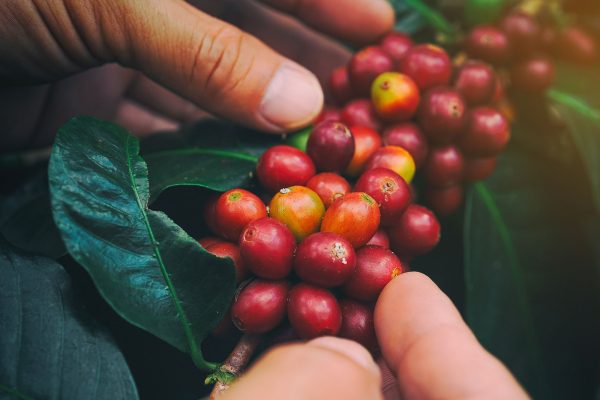
If I asked you what the most gripping addiction in the country was, what would your first guess be? Surely it’s something you’ve heard about it in the news lately, right?
Shockingly, the answer is caffeine: America’s most popular drug. Over 85% percent of adults consume caffeine every day and a large portion of that consumption is in the form of coffee.
Coffee’s stimulating effects on our brain are a form of addiction. Anyone who’s ever had a crippling headache from caffeine withdrawal can attest to this.
Knowing more about this natural marvel will make you truly appreciate your next cup of joe that much more. So, let’s take a deeper dive inside the coffee cherry to understand what’s going on and the journey it takes to your kitchen counter.
The Coffee Plant
Let’s start at the beginning. There’s a pretty good chance that the average coffee-lover would have a hard time describing what a coffee plant looks like.
Coffee trees can grow to over 30 feet high and have been cultivated by humans for over 14 centuries. The first evidence of coffee drinking originates in the Ethiopian peninsula, where much of the coffee production we have today still takes place.
Coffee trees undergo lots of pruning to conserve energy for riper fruit, which leads to better tasting coffee. It can take a year or more for coffee plants to begin producing cherries.
There are two main categories of coffee tree varieties:Coffea Arabica and Coffea Canephora(more commonly known as Coffea Robusta).
Arabica is well-known in the specialty coffee world for its higher quality beans, despite having a lower yield than Robusta. Arabica beans tend to sell at higher prices on the market and are more sought after.
Arabica also tends to have a more complex, sweet, and mild flavor with higher acidity. Common flavor notes for Arabica include things like berries, caramel, and stone fruit.
Robusta varieties tend to produce coffee that is stronger and harsher in taste, with grain-dominant flavors and nutty after-tastes. Robusta varieties grow in lower altitudes than Arabica and are much less vulnerable to pests and harsh weather patterns.
These days, much of the commercial coffee growing industry lies within Africa, South and Central America, and Indonesia. However, new growing regions are being explored due to climate change and shifting weather patterns, for example, Hawaii.
New growing regions means new coffee cherry characteristics and tastes are beginning to emerge in the ever-changing coffee market.
Anatomy of a Coffee Cherry
Here we’ve reached the second phase of cultivation: the coffee cherry itself. A coffee cherry is a small red cherry with a waxy skin that grows in bundles up and down the plant’s branches.
Two seeds called ‘beans’ (see where we’re going here?) lie inside the cherry, facing each other. These seeds are then cultivated, washed, and roasted for your drinking pleasure.
Beneath the outer layer of the coffee cherry lies the mesocarp, or pulp, much like an orange. The mucilage comprises the inner-most layer of pulp and contains many complex sugars that provide sustenance for the seed. The mucilage and is an important element to the processing of the coffee — more on that later.
A paper-y shield, known as the parchment (or the endocarp if you want to sound fancy), protects the beans inside the cherry. The parchment will come off during processing as well, depending on the method.
Coffee Cultivation and Processing
Cultivating a coffee cherry takes precision and knowledge of ripening color changes. Once cultivated, coffee cherries begin a long journey to end up in your hands as roasted coffee.
There are 3 main processing methods for which coffee is produced: washed, dry, and honey processed.
1. Washed
This coffee process focuses solely on the bean. For this reason, many specialties and single origin beans are produced this way in order to highlight the bean characteristics. The washed process works by washing away the outer layers of the cherry to reveal the cleaned coffee beans.
2. Dry Process
This ancient method stems from Ethiopia and allows for little disruption of the coffee cherry. The entire cherry is allowed to wither and dry out on the beans, leaving a coffee bean with an outer layer of fruit on the surface that takes on a reddish brown hue.
This produces a cup, that if done right, can taste like a tropical fruit cocktail!
3. Honey/Pulped Natural
This process is quite similar to the dry process. The only difference is that the skin and pulp are removed during harvest, with the sugary mucilage allowed to dry on the bean. This results in a cup with brown sugar, and — you guessed it— honey sweetness to it.
Because of these rigorous harvesting and labor-intensive processing methods, it’s important to support Fair Trade within the rapidly-changing coffee industry. Did you know coffee was the first ever product to be marketing with a Fair Trade label?
These green coffee beans are now ready for roasting!
Common Questions
What are the environmental implications of coffee production, especially given the mention of climate change affecting growing regions?
Coffee production has significant environmental implications, particularly in light of climate change. As the article mentions, shifting weather patterns are forcing the exploration of new growing regions, such as Hawaii. This expansion can lead to deforestation and habitat loss as land is cleared for coffee plantations. Additionally, traditional coffee growing often relies on monoculture practices, which can degrade soil quality and reduce biodiversity. Climate change itself poses a threat to existing coffee-growing regions, potentially altering temperatures and rainfall patterns that coffee plants depend on. This could lead to decreased yields, increased vulnerability to pests and diseases, and ultimately, changes in global coffee supply and quality. Sustainable farming practices and adaptation strategies are becoming increasingly crucial to mitigate these environmental impacts and ensure the long-term viability of coffee production.
How do the different processing methods (washed, dry, and honey) affect the final taste of the coffee?
The three main processing methods – washed, dry, and honey – significantly influence coffee’s final flavor profile. Washed processing, which removes all fruit layers before drying, tends to produce a cleaner, brighter taste that highlights the bean’s inherent characteristics, often resulting in more acidic and floral notes. Dry processing, where the entire cherry dries on the bean, typically yields a fuller-bodied coffee with complex, fruit-forward flavors and a sweeter, wine-like quality. The honey process, a middle ground where some mucilage remains on the bean during drying, often creates a cup with heightened sweetness and a syrupy body, featuring notes of brown sugar and, true to its name, honey. Each method uniquely impacts the coffee’s acidity, body, and flavor complexity, allowing for a diverse range of taste experiences from the same coffee cherry.
What exactly does Fair Trade mean in the context of coffee production, and how does it benefit coffee farmers?
Fair Trade in coffee production is an ethical certification system that aims to ensure better trading conditions and promote sustainability for coffee farmers, particularly in developing countries. It sets standards for working conditions, wages, and environmental practices. For coffee to be Fair Trade certified, buyers must pay a minimum price to producers, which acts as a safety net when market prices drop. Additionally, a Fair Trade premium is paid to farmer cooperatives for community development projects. This system helps protect small-scale farmers from market volatility, promotes more sustainable farming practices, and supports community development. By purchasing Fair Trade coffee, consumers contribute to improved livelihoods for coffee farmers and more equitable global trade practices in the coffee industry.
Final Thoughts
Now that we understand the ins and outs of the coffee cherry, you’ll forever stare down into that bag of magic beans differently. Hopefully, this knowledge will make you appreciate the complex process it has gone through to get to you.
Stay in the loop on news and trends about coffee production around the world and stay in touch on our blog!
